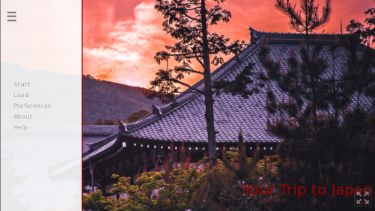Field Trip from Home; Student outputs
Explore the excellent and varied work produced by our students during their Field Trip from Home module.

Tokyo Mixtapes by Luke Wakeman
For his final work, Luke developed a series of soundtracks for specific locations in Tokyo, with the music reflecting the social, historical and cultural character of different neighbourhoods at different historical periods. He chose three areas to focus on, Kichijoji of the 1970s, Harajuku of the 1980s and Shibuya of the 2000s. The soundtracks in his creative output are accompanied by posters and a narrative taking the reader into the soundscape of the neighbourhood and its specific history.

Your trip to Japan - Shannon Greaves
For her creative output Shannon developed an interactive video game story, where the player can explore different neighbourhoods of Tokyo through a visual novel. In her exegesis she explores the embodiment of being in a place and participatory practices that enable one to experience a space in a multisensory manner. Through her video game she has tried to engage with these sensory nature of the city through the embedding of real images and sounds into her game and bring Tokyo closer to the player. The player is guided though the city by a Fox named Guidey who the player interacts with.

Silent City by Flora Lee
For her final output Flora developed a manga in which she reflected not only the sensory landscape of Tokyo, but also the sociality and everyday life of Tokyoites through her main character’s navigation through the cityscape. In her exegesis, excerpts of which you can read below, Flora explains her choices for the mode of representation and how she has conveyed sound in her work to the reader.

Harajuku History by Bethany Whitaker
For her final output Bethany submitted a magazine on Harajuku’s fashion subcultures and their history, with a full breadth of explosive visuals accompanying detailed summaries of each specific fashion style and their history. Bethany modelled for her magazine herself, recreating iconic Harajuku styles, arranging them into visual posters that were followed by a summary of the characteristics and meaning of the styles as well as their history.

Crossing Borders by Catarina De Sa Gomes
Catarina has created a playlist as her final creative output. She had done this on spotify, and you can listen to it though the link below. Through her playlist Catarina wanted to explore the multiculturalism in Tokyo, something that is often not prominently recognised in representations of Japan that tend to emphasise the supposed homogeneity of the Japanese.
From Kankaku to Chikaku by Tabitha Malcolm
Tabitha chose to develop a visual representation of sound for her final work, creating a 3D model of a typical Tokyo street, where she marked out various areas and objects that emit sounds, trying to create a visual imagery to accompany and represent them. In her exegesis, Tabitha explores the process of creating her work as well as the nature of doing field work from afar, and the challenges and opportunities this gives rise to.
Cosplay by Alex Tanser
Alex, like most of the students in fact, utilised his existing skills and interests in his creative output. Alex is a YouTuber in his spare time and therefore decided to create a video as his final output in which he explores the shades and characteristics of Japanese Cosplay (Costume Play). With the benefit of his studies and research for this module, in this five minute video Alex explores the history of Cosplay, its relationship with Japanese Manga as well as the role cosplay plays in Japanese society, particularly among the younger generations.


